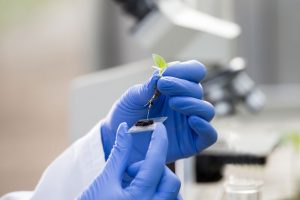If you’re using these sources to make a point about genetically engineered food, you’ll want to rethink your sourcing — or prepare to get laughed at
Here’s a tip for all the anti-GMO activists out there: If you ever want to get the last word in during a debate about biotechnology, just post a link to Benbrook or Séralini or Seneff. Those kinds of sources will stop a discussion in its tracks, not because they carry any scientific validity but because you will typically be seen as either too far lost down the rabbit hole or as if you aren’t really putting forth any effort. And that’s disheartening for those of us who are interested in having real discussions about our food system.
There have been countless times when I’ve been engaged in a discussion and the other person posts a link to an old study involving rats. Yes, that study. The 2012 one that now bears the headline in the journal Food and Chemical Toxicology: “RETRACTED: Long term toxicity of a Roundup herbicide and a Roundup-tolerant genetically modified maize.”
Though initially hailed as a bombshell study, playing a major role in shaping media and social media pubic opinion, it was later found that the study had an inadequate sample size, used a breed of rat prone to spontaneous tumors, and lacked statistical analysis. Couple that with movie- and book tie-ins pegged to the research and journalists being pressured to sign agreements disallowing them from speaking with any research team member besides lead author Gilles-Éric Séralini himself, it’s no wonder so many red flags were raised.
To this day, no name in the agricultural and food sciences conjures an eye-roll quite like “Séralini.” His is activism masquerading as science, and that can be a dangerous (albeit popular) thing on social media. Sure, everyone has their preferred sources, and no matter what you believe personally or who’s research you trust, there are some you need to steer clear of to have any credibility when discussing science.
The work of Séralini is one of main reasons that many science enthusiasts in social media debates centered on genetically engineered food (aka GMOs) will ask for “reliable sources” as supporting evidence for claims. Séralini is not considered reliable, nor are many of the other people marketing themselves to the public. The pervasiveness of some of these discredited reports and fringe personalities fuel the toxicity against and frustrations of pro-GMO advocates in the social media sphere. It becomes hard to combat the indoctrination of the David Wolfes and Dr. Ozes and Food Babes of the world. The same “research” gets circulated over and over. There’s nothing new coming out to support that side of the debate, it’s just being rewritten by another website that has “health” or “natural” in the url, and thus props itself up on a loop indefinitely.
At the very least, any anti-GMO activist referencing Séralini would be better off pointing to his republished version in the journal Environmental Sciences Europe, where he analyzed his data differently. Because that journal is less rigorous and the research still wrought with very apparent flaws, that second paper wasn’t as headline-grabbing as the 2012 paper, and Séralini’s credibility may be too far damaged — but at least that second paper wasn’t publicly and humiliatingly retracted.

To be clear, no source is going to be entirely free of perceived bias. Not academics, not mainstream media, not niche publishers. People will find fault at every turn, and there should be a duty to limit negative perceptions as much as possible. It’s here that I believe that people who are pro-GMO (self included) tend to have the advantage.
Many who are pro-GMO better anticipate perceived conflicts of bias than anti-GMO folks do. Pro-GMOers understand that a link to corporate data won’t be trusted, so they look for peer-reviewed sourcing. They understand that one agency’s guidance isn’t enough, so it’s better to show the broader consensus of science as conveyed across groups such as the World Health Organization, the U.S. Environmental Protection Agency, the American Medical Association, the European Commission, and Health Canada.
It’s rare, when communicating with the public or opposing advocacy groups, for advocates of genetic engineering to cite certain sources or scientists that are known to be perceived as biased. Doing that doesn’t usually move the conversation forward. When trying to engage with people, perceptions and emotional responses are going to trump scientific evidence every time. So GMO advocates make the effort to find sources that not only operate independently, but appear independently, too.
» Related: Anti-Pesticide Researchers May Have Committed Serious Ethics Breaches
The biggest question, in the heat of a discussion, is how do a you move past what is popularly believed to be a bad source? Simply dismissing it means that you are dismissing the foundation of someone’s belief or understanding of the world. Combating it often intensifies the issue and suggests superiority. These kinds of tactics don’t connect; they don’t help people change their minds. As tempting as it is to write off the person who posts a link to an anti-GMO Charles Benbrook paper, for example, find out the reasons the commenter likes that paper. Is it environmental sustainability? Then narrow the focus to the environment. Is it financial? Talk about how the diverse nature of farming offers varying profitability.
No single production method — whether it’s labeled as “biotechnology” or “natural” or “sustainable” — is feasible or ideal in every situation. If you get to the root cause of why someone supports the work of Séralini or the activism of Food Babe, you can address the specifics of their perspective without playing into the questionable sourcing they took to get to that viewpoint.
Ryan Tipps is the founder and managing editor of AGDAILY. He has covered farming since 2011, and his writing has been honored by state- and national-level agricultural organizations.



